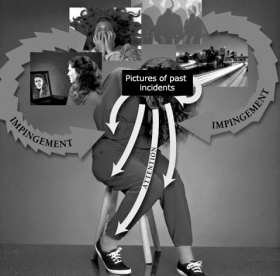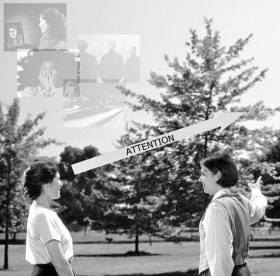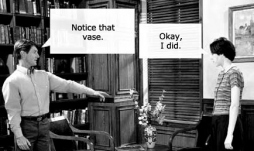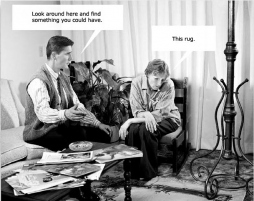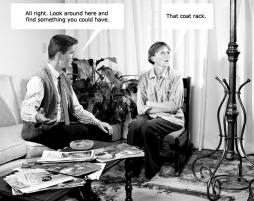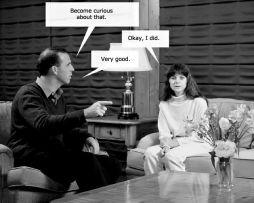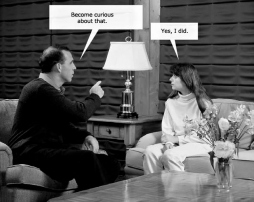In addition to nutritional handling, the other approach to the drug withdrawal problem consists of
Because drugs tend to push a person into experiences of the past and stick his attention in these moments, processes which pull more of a person’s attention outward help unstick him from the past.
There are many Objective Processes in Scientology which accomplish this.
Objective Processes help a person get into
Five Objective Processes are included here.
It is best to do these processes in a quiet place, free of distraction or interruption and with enough time to do the process until the person being helped has good indicators and has had a cognition. Indicators are conditions or circumstances arising during a process which indicate (point out or show) whether it is going well or badly. The person looking brighter or more cheerful, for example, has good indicators. A cognition is a new realization about life. It is a “What do you know, I...” statement; something a person suddenly understands or feels.
These processes are given to the person in addition to the drug bomb and Cal-Mag. They are very effective when given several times a day to help get the person through the period of withdrawal from drugs, which usually takes about a week or less. For example, a person could be given one of these processes in the morning, and some hours later he could be given another. A person going through withdrawal often sleeps considerably more than usual, especially at the beginning of such a program. Therefore, one would not go at this too strenuously; giving the person two or three of these Objective Processes each day should be sufficient to get a result.
“Notice That”
This process directs a person’s attention off his body and out onto the environment. The procedure is as follows:
1. Tell the person you are going to process him and briefly explain the procedure.
2. The command used is:
“Notice that _______________ (indicated object).”
Ensure he understands it.
3. Indicate an obvious object by pointing to it. Tell the person, “Notice that _______________ (object).”
4. When the person has done so,
5. Continue giving the command, directing the person's attention to different objects in the environment. Be sure to acknowledge the person each time after he has carried out the command.
For example, say:
“Notice that chair.”
“Thank you.”
“Notice that window.”
“All right.”
“Notice that floor.”
“Very good.”
And so on.
6. Continue the process until the person being helped has good indicators and has had a cognition.
You can end the process at this point. Tell the person, “End of process.”
“Notice That” | |
A Havingness Process
1. Tell the person you are going to process him and briefly explain the procedure.
2. The command used is:
“Look around here and find something you could have.”
Ensure he understands it.
3. Give the command, “Look around here and find something you could have.”
4. When the person has done so, acknowledge him by saying, “Thank you” or “Okay” or “Good,” etc.
5. Continue giving the command. Be sure to acknowledge the person each time after he has carried out the command.
For example, say:
“Look around here and find something you could have.”
“Thank you.”
“Look around here and find something you could have.”
“Good.”
“Look around here and find something you could have.”
“All right.”
“Look around here and find something you could have.”
“Very good.”
And so on.
6. Continue the process until the person being helped has good indicators and has had a cognition. You end the process at this point. Tell the person, “End of process.”
A Havingness Process | |
“Touch That”
This process is done with both persons walking about, or if the person being helped is not able to walk, they may be seated at a table with a number of objects scattered on its surface. The procedure is as follows:
1. Tell the person you are going to process him and briefly explain the procedure.
2. The command used is:
“Touch that _______________ (indicated object).”
Choose different objects in the room for the person to touch.
Ensure the person understands the command.
3. Give the command, “Touch that _______________ (indicated object).”
4. When the person has done so, acknowledge him.
5. Continue giving the command. Be sure to acknowledge the person each time after he has carried out the command.
For example, say:
“Touch that table.”
“Thank you.”
“Touch that chair.”
“Good.”
And so on.
6. Continue the process until the person being helped has good indicators and has had a cognition. You end the process at this point. Tell the person, “End of process.”
“Touch That” | |
Touch and Let Go on Room Objects
This is a very good technique and will raise the person’s
1. Tell the person you are going to process him and briefly explain the procedure.
2. The commands used are:
a. “What in the room is really real to you?”
b. “Go over and touch it.”
c. “Now let go of it.”
Ensure he understands them.
3. Give the command, “What in the room is really real to you?”
4. When the person has answered, acknowledge him.
5. Then give the next command, “Go over and touch it.”
6. When the person has done so, acknowledge him.
7. Then give the next command, “Now let go of it.”
8. When the person has done so, acknowledge him.
9. Continue giving the commands in this sequence: a, b, c, a, b, c, etc. Be sure to acknowledge the person each time after he has carried out the command.
For example, say:
“What in the room is really real to you?”
“Thank you.”
“Go over and touch it.”
“Good.”
“Now let go of it.”
“All right.”
“What in the room is really real to you?”
“Very good.”
And so on.
10. Continue the process until the person being helped has good indicators and has had a cognition. You end the process at this point. Tell the person, “End of process.”
Touch and Let Go on Room Objects | |
“Become Curious About That”
This is a basic Objective Process and is very simple. The procedure is as follows:
1. Tell the person you are going to process him and briefly explain the procedure.
2. The command used is:
“Become curious about that.”
Ensure he understands it.
3. Indicate an object in the room by pointing at it and say, “Become curious about that.”
You don’t call the object by name, you just indicate it. You don’t say, “Become curious about that chair.”
4. When the person has done so, acknowledge him by saying, “Thank you” or “Okay” or “Good,” etc.
5. Continue the procedure giving the command. Be sure to acknowledge the person each time after he has carried out the command.
For example, say:
“Become curious about that.” (Indicate an object.)
“Thank you.”
“Become curious about that.” (Indicate an object.)
“Good.”
“Become curious about that.” (Indicate an object.)
“All right.”
“Become curious about that.” (Indicate an object.)
“Very good.”
And so on.
6. Continue the process until the person being helped has good indicators and has had a
“Become Curious About That” | |
a type of process which helps a person direct his attention off himself and onto his environment and the people and things in it. Objective refers to outward things, not the thoughts or feelings of the individual. Objective Processes deal with the real and observable. They call for the person to spot or find something exterior to himself. See also process in this glossary.
the time which is now and which becomes the past almost as rapidly as it is observed. It is a term loosely applied to the environment existing in now.
a surprising disclosure of something previously unknown or not realized.
give (someone) an acknowledgment, something said or done to inform another that his statement or action has been noted, understood and received.
the feeling that one owns or possesses; it can also be described as the concept of being able to reach or not being prevented from reaching.
that which appears to be. Reality is fundamentally agreement; the degree of agreement reached by people. What we agree to be real is real.
a new realization about life. It is a “What do you know, I…” statement; something a person suddenly understands or feels.

